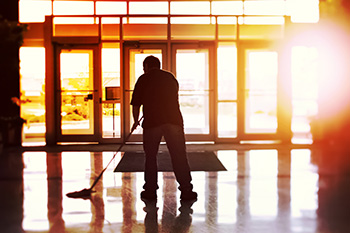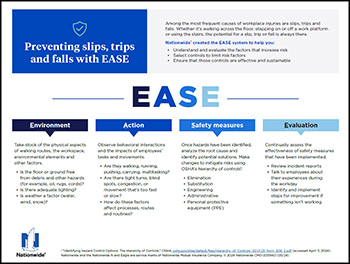Safeguarding against slip, trip and fall incidents

Slip, trip, and fall (STF) incidents extend far beyond mere embarrassment—they represent a significant concern for businesses. According to the U.S. Bureau of Labor Statistics (BLS), which collects and analyzes labor, industry and economic data, STF accidents rank among the top 3 causes of injuries that result in employee days away from work and work-related fatalities.
In 2022 alone, BLS notes there were 450,540 days away from work from STF injuries. These incidents not only lead to human suffering and loss for the worker, but they also increase the financial impact of workers’ compensation claims, create liability risks, disrupt business continuity, and impact overall productivity and profitability. More importantly, BLS reports that slip and fall events in 2022 led to 865 work-related fatalities.
This article focuses specifically on same-level slip, trip and fall incidents, exploring their primary causes, methods for identifying workplace risk factors, and effective strategies to mitigate these risks.
Consider the primary causes of same-level slips, trips and falls
Same-level falls occur when there is a loss of balance. Apart from being impacted by a medical or physical condition, most people do not just fall to the ground. When standing, stepping up, or leaning, falls typically happen when there is an unexpected change in the stability of the worker or the work surface/support. When moving, this happens when there is an unexpected change in footing or a sudden interruption in motion (usually due to a slip or trip). Whether it is a slippery surface, a weak or uneven floor, or an unforeseen obstacle, these incidents catch us off guard and can lead to a fall and potentially serious consequences.
The first step to effectively protect your workplace from slip, trip and fall incidents, is to better understand two of the basic causes that lead to these unexpected changes: environment and actions.
Environment: We often think of the environment as just the physical aspects and obvious hazards of the walk/work surface (like that slippery floor or trip hazard), but the workplace environment encompasses more. It also includes the surrounding environmental elements (light, glare, materials, processes, waste/residue, workplace design) and the social environment or work culture that influences behaviors. Workplace environments and subsequent physical hazards don’t just happen. They are either created or allowed to develop/exist and are often the result of actions or processes (e.g., cracked flooring from heavy loads, leaks from equipment or machinery, plastic banding left on the floor). It’s also important to remember that environments are dynamic and can change with the time of day, season or high production demands.
Actions: Actions include how people move around and the work they do —walking, running, leaning, pushing, pulling, or carrying items. The type of tasks and the way they are performed is significant - e.g., moving quickly, changing direction, leaning or reaching, awkward postures, moving with blocked vision or unstable loads, and multi-tasking. These are intentional, predictable, and controllable behaviors that are often influenced or created by the environment (e.g., using a makeshift step to reach a high shelf, walking while looking at paperwork or a text, pushing an overloaded cart).
Understanding the how/why behind environment, action risk factors and the impact they have on each other is critical to effecting change and developing controls. It is important to consider how the environment can influence actions, and how actions can change the environment.
Consider the ins and outs of the workspace
Many workplaces are a “four-wall” setting with designated work areas and limited foot traffic; however, when evaluating environments and actions, it is important to include both the internal and the external factors at play.
Internal factors: Within the work environment, there’s a myriad of physical features that can contribute to accidents. Things like floor hazards (water, oil, or other materials on the production floor), the layout of the work area (the arrangement of workstations, corridors, and common spaces), cluttered pathways, crowded work areas, cramped corners, blind spots, and poorly organized spaces can all impact safety. Movement also plays a factor – the deliberate steps, turns and occasional distractions. Whether it’s rushing between tasks or not paying attention to our surroundings, behavior matters.
External factors: As we venture outdoors, whether it is part of the job or part of getting to the job, we encounter a realm of external influences. These may be more difficult to control as seasons, varying weather conditions and unexpected hazards all contribute to slip, trip and falls. But how these conditions are tracked into the workplace via footwear and entryways is controllable. If your business welcomes clients or vendors, they could slip, trip, or fall too. That opens the door to potential liability claims. So, keeping an eye on those outdoor hazard’s matters.

Develop prevention with EASE
To help businesses apply the above concepts to the prevention of slip, trip and fall exposures, Nationwide developed the EASE concept (Environment, Action, Safety Controls, and Evaluate). This is a comprehensive approach that prompts the user to consider risk factors related to environment and actions in order to develop effective solutions and ensure sustainability. Employers should regularly assess walking and working surfaces, especially in high-traffic areas or those with a history of slip, trip, and fall incidents. Prioritizing hazard identification and mitigation is essential for a safe work environment.
E – ENVIRONMENT
Look around. Consider the physical surface, environmental elements, and other influencing factors. Is the surface dry, slip-resistant, uniform, and free from hazards like oil, rugs, or cords? Also, assess lighting, glare, and weather conditions (water, wind, snow).
A – ACTION
Assess employee behavior during tasks: walking, running, pushing, carrying, multitasking. Consider tight turns, blind spots, congestion, and movement speed. Evaluate their impact on processes, routes, and routines.
S – SAFETY CONTROLS
Prioritize identified hazards by severity to determine what to address first. Use OSHA’s hierarchy of controls - elimination, substitution, engineering, administrative and personal protective equipment to make changes that mitigate risks.
E – EVALUATE
Continually assess the effectiveness of controls by reviewing incident reports and gathering employee feedback to assess safety measures. Adjust and improve if something is not working.
Develop prevention through design
The most cost-effective prevention of slip, trip, and fall incidents begins with thoughtful planning. Ideally this is done during the design stage. If that isn’t feasible, retrofitting to better suit the job task is an alternative, although it may incur higher costs in the long term. Some key considerations for effective design include:
- Flooring surface: Carefully consider the slip resistance and maintenance of flooring surfaces ensuring that it aligns with the specific type of work. Consider the potential for contaminants from production and external sources, as well as the arrangement of work areas and required travel.
- Walkways: Create designated walkways that have suitable friction surfaces, are clearly labeled, and free of obstructions or changes in elevation. Where changes in elevation must be present, they should be marked to alert employees.
- Travel distance/path: Design work tasks to minimize unnecessary travel and to reduce the need to travel through higher hazard areas.
- Visibility: Ensure adequate lighting, consider the impact of glare and other impacts to visibility such as floor pattern and color selection. When areas are poorly lit, individuals may not notice hazards on the floor, such as spills, uneven surfaces, or obstacles. Well-lit spaces allow workers to identify potential risks and navigate safely. Don’t forget that some visibility issues are seasonal. Remember, you can’t avoid what you can’t see!
- Distractions: Minimize distractions that take attention away from safe travel e.g., multi-tasking, texting, or other mobile device usage. There should be a safe mobile device policy that details where and when an employee can use their device during working hours. This can help create safe work practices to minimize distractions while completing tasks.
- Maintenance and Spill Response: Efficiently managing necessary maintenance tasks and handling emergencies is crucial for minimizing incidents. Consider scheduling cleaning and wet activities during low-traffic periods (avoiding lunch breaks and shift changes) to reduce risks. After wet mopping, follow up with dry mopping to further decrease the risk of slippery surfaces. Prioritize high-risk areas prone to spills or water accumulation during cleaning efforts. Regular checks and appropriate cleaning practices are essential for maintaining safety.
When incidents occur
In the event of a slip, trip or fall incident, employers should:
- Assess the Situation: Quickly evaluate the severity of the incident. Is the employee injured? Is there a risk of further harm?
- Provide Immediate Aid: If the employee is injured, call for medical assistance immediately. Administer first aid if you’re trained to do so.
- Secure the Area: Ensure the safety of others by cordoning off the affected area. Use caution signs or barriers to prevent additional slips or falls.
- Document the Incident: Record details of the incident, including the location, time, and circumstances. This documentation is essential for reporting and investigation purposes.
- Investigate the Cause: Determine why the slip, trip, or fall occurred. Was it due to a wet floor, an obstacle, poor lighting, or other hazards?
- Address the Hazard: Take corrective action to prevent future incidents:
- Spills: Clean up spills promptly and place caution signs.
- Obstructions: Remove objects or obstructions from walkways.
- Floor Conditions: Ensure floors are clean, dry, and not slippery.
- Lighting: Improve lighting in dim areas.
- Footwear: Encourage appropriate footwear for the environment.
- Provide Support: Assist the employee in seeking medical attention or reporting the incident to their supervisor.
Getting employee buy-in
Creating a culture of safety in the workplace is crucial for employers. Such a culture not only positively impacts the workforce but also encourages employee engagement in safety programs.
To establish an effective safety culture, it must start from the top and involve all levels of the company. Employers should communicate safety expectations clearly to employees. Additionally, when an employee gets injured, demonstrating care and support enhances loyalty and morale, as it signals genuine concern for their well-being.
How Nationwide® can help
Nationwide offers a comprehensive program to address slip, trip and fall risks, including tools to conduct evaluations to identify and assess hazards.
Nationwide’s EASE and FLOORS programs are great resources that can be used to reinforce ways to reduce the potential for a slip, trip or fall. Our ‘Slip-Trip-Fall Risk Assessment Tool’ can help identify program, operational and/or physical changes in your environment.
Other important resources include:
- Nurse Triage Hotline If an employee has a non-life-threatening injury, the Nurse Triage Hotline is a great resource. A registered nurse will help assess the need for medical care on non-life-threatening injuries and will file a Workers’ Compensation claim for you, if needed.
- Nationwide Claims If an employee requires immediate medical attention, after calling emergency services, the injury should be reported to the Nationwide claims center within 24 hours at 1-800-421-3535. A quick response by a claims adjuster to the injured person can help ensure efficient and appropriate claims handling.
For your risk management and safety needs, visit My Loss Control Services.
